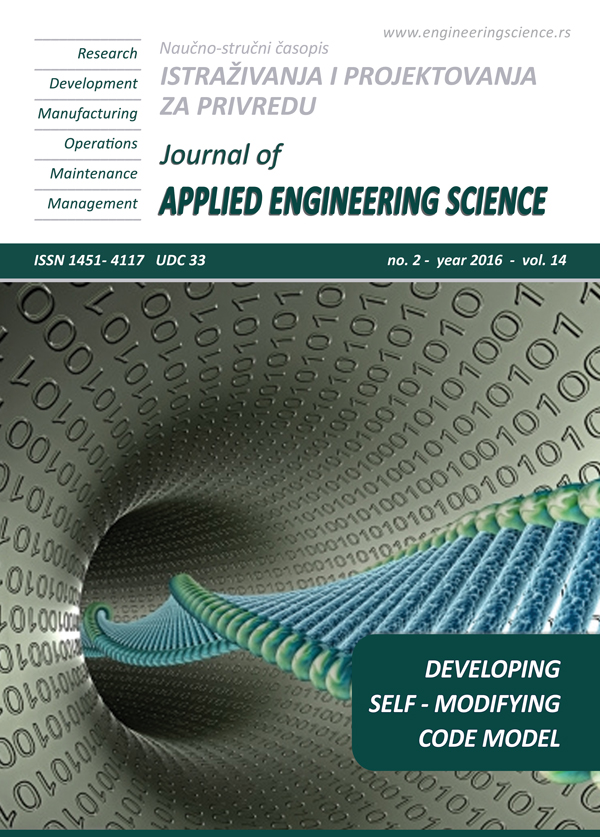BENCHMARK FOR NUMERICAL ANALYSIS OF STEEL AND COMPOSITE FLOORS EXPOSED TO FIRE USING A GENERAL PURPOSE FEM CODE
Abstract
Increasing number of tests on structures in fire conditions offers valuable information regarding the global and local behaviour. The output data of these experiments can be considered to be a good opportunity for validation of numerical models. Nevertheless, in some fortuitous cases, inaccurate input of numerical models may lead to results matching the experimental ones. The validation and/or verification of advanced calculation models for the fire design are an important issue not only for computer code developers, but also for designers and authorities. The validation of an advanced calculation model is usually linked with the comparison to experimental results, while the verification is related to the comparison to analytical solutions or to the results given by other computer codes. The paper presents a benchmark for both thermal and structural analysis of a composite floor subjected to fire using beam and shell elements. The numerical analysis is performed with a general purpose finite-element code. The input and the output of the thermo-mechanical analysis are detailed, with respect to a real scale fire test.
References
ABAQUS. (2011) ABAQUS Documentation 6.11, Providence, RI, USA: Dassault Systèmes.
ANSYS. (2008) ANSYS® Academic Research, Release 14.0.
Bailey, C.G. and Moore, D.B. (2000) The structural behaviour of steel frames with composite floorslabs subject to fire: Part 1:Theory. The Structural Engineer, 78 (11), 19-27.
Both, I., Wald, F. and Zaharia, R. (2015) Design issues of thermal induced effects and temperature dependent material properties in Abaqus, 7th International Conference on Materials Characterisation VII, 22-24 May 2015, Valencia, France.
C.E.N. (2002) EN 1991-1-2, Eurocode 1: Actions on structures - Part 1-2: General actions - Actions on structures exposed to fire, Brussels.
C.E.N. (2004) EN 1992-1-2, Eurocode 2: Design of concrete structures - Part 1-2: General rules - Structural fire design, Brussels.
C.E.N. (2004) EN 1994-1-2, Eurocode 4 - Design of composite steel and concrete structures - Part 1-2: General rules - Structural fire design, Brussels.
C.E.N. (2005) EN 1993-1-2, Eurocode 3: Design of steel structures - Part 1-2: General rules - Structural fire design, Brussels.
Celik, I.B. (2008) Procedure for Estimation and Reporting of Discretization Error in CFD Applications. Journal of Fluids Engineering. 130(7), DOI 10.1115/1.2960953.
http://dictionary.reference.com/browse/benchmark, retrieved on November 22nd 2014.
Franssen, J.-M. (2005) Safir- A thermal/structural program modelling structures under fire. Engineering Journal, 42(3), 143-158.
Gillie, M. (2009) Analysis of heated structures: Nature and modelling benchmarks. Fire Safety Journal, 44 (5), 673-680.
Huang, Z., Burgess, I.W. and Plank, R.J. (1999) The influence of shear connectors on the behaviour of composite steel-framed buildings in fire. Journal of Constructional Steel Research, 51 (3), 219-237.
Kruppa, J. and Zhao, B. (1995) Fire resistance of composite beams to Eurocode 4 Part 1.2. Journal of Constructional Steel Research, 33 (1), 51-69.
Kwasniewski, L. (2013) Application of grid convergence index in FE computation, Bulletin of the Polish Academy of Sciences, March, 123-128.
MACS+, (2014) RFCS project “Membrane action in fire design of composite slab with solid and cellular steel beams - valorisation” (MACS+). Available: http://www.macsfire.eu/.
Stadler, M. (2012) Design of Composite Slab Systems in Case of Fire Using Simplified Finite Element Analyses. Ph.D. Thesis, Technical University in Munich.
The Steel Construction Institute. (2003) Design recommendations for composite steel framed buildings in fire. Part of final report for ECSC project 7210 PA, PB, PC, PD112.
Vulcan. (2014) [Online], Available: http://www.vulcan-solutions.com/ [2 November 2014].
Wald, F., Burgess, I., Kwasniewski, L., Horova, K. and Caldova, E. (ed.). (2014) Benchmark studies-Verification of numerical models in fire engineering, Prague: CTU Publishing House.
Zaharia, R., Vulcu, C., Vassart, O., Gernay, T. and Franssen, J.-M. (2013) Numerical analysis of partially fire protected composite slabs. Steel and Composite Structure, 14(1), 21-39.
Zhao, B., Roosefid, M. and Vassart, O. (2008) Full scale test of a steel and concrete composite floor exposed to ISO fire, Structures in fire (Proceedings of the Fifth International Conference), 28-30 May 2008, Singapore.
Zhao, B. and Roosefid, M. (2010) Experimental and numerical investigations of steel and concrete composite floors subjected to ISO fire Condition, Structures in fire (Proceedings of the Sixth International Conference), 2-4 June 2010, East Lansing, USA.

